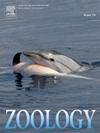Altitude correlates with dorsal −but not ventral− scale number and dimension in a lacertid lizard
IF 1.6
3区 生物学
Q2 ZOOLOGY
引用次数: 0
Abstract
The primary function of the keratinised skin of squamates is modulating heat load, reducing water loss rates and protecting from abrasion. Furthermore, reptilian scale size and shape variation have also been observed depending on the habitat and associated environmental conditions. However, how climate can modulate intraspecific scale characteristics of reptile species in temperate regions is still a subject of debate. Here, we investigate the potential correlation between climate and lizard scalation for a European lacertid lizard. From 221 museum collection specimens of Podarcis muralis, we recorded body measurements and sex information and counted the number and size of dorsal scales and the number of ventral scales per individual. We obtained each specimens’ capture location information from which we extracted environmental data like temperature, precipitation, humidity, wind speed, solar radiation and altitude. We found that individuals that inhabited higher elevations tended to have fewer and larger dorsal scales than those from lowlands, as a potential adaptation to decrease water loss in arid and windy environments. We did not find a correlation between the number of ventral scales and environmental conditions, except for wind speed. This study uncovers an intraspecific adaptive mechanism in an environment gradient that is key to understanding species' potential adaptation to future climatic conditions.
海拔高度与肩蜥背部鳞片的数量和尺寸相关,而与腹侧鳞片无关
有鳞类动物角质化皮肤的主要功能是调节热负荷、降低失水率和防止磨损。此外,根据栖息地和相关环境条件的不同,爬行动物的鳞片大小和形状也会发生变化。然而,气候如何调节温带地区爬行动物种内的鳞片特征仍是一个争论的话题。在此,我们研究了欧洲一种漆蜥的气候与蜥蜴鳞片之间的潜在相关性。我们从 221 个博物馆收藏的 Podarcis muralis 标本中记录了身体尺寸和性别信息,并统计了每个个体的背鳞数量、尺寸和腹鳞数量。我们获得了每个标本的捕获地点信息,并从中提取了温度、降水、湿度、风速、太阳辐射和海拔等环境数据。我们发现,居住在海拔较高地区的个体背鳞往往比居住在低洼地区的个体更少、更大,这可能是为了适应干旱多风的环境,减少水分流失。除风速外,我们没有发现腹鳞数量与环境条件之间存在相关性。这项研究揭示了环境梯度中的种内适应机制,这对了解物种对未来气候条件的潜在适应性至关重要。
本文章由计算机程序翻译,如有差异,请以英文原文为准。
求助全文
约1分钟内获得全文
求助全文
来源期刊

Zoology
生物-动物学
CiteScore
3.90
自引率
0.00%
发文量
37
审稿时长
70 days
期刊介绍:
Zoology is a journal devoted to experimental and comparative animal science. It presents a common forum for all scientists who take an explicitly organism oriented and integrative approach to the study of animal form, function, development and evolution.
The journal invites papers that take a comparative or experimental approach to behavior and neurobiology, functional morphology, evolution and development, ecological physiology, and cell biology. Due to the increasing realization that animals exist only within a partnership with symbionts, Zoology encourages submissions of papers focused on the analysis of holobionts or metaorganisms as associations of the macroscopic host in synergistic interdependence with numerous microbial and eukaryotic species.
The editors and the editorial board are committed to presenting science at its best. The editorial team is regularly adjusting editorial practice to the ever changing field of animal biology.
 求助内容:
求助内容: 应助结果提醒方式:
应助结果提醒方式:


